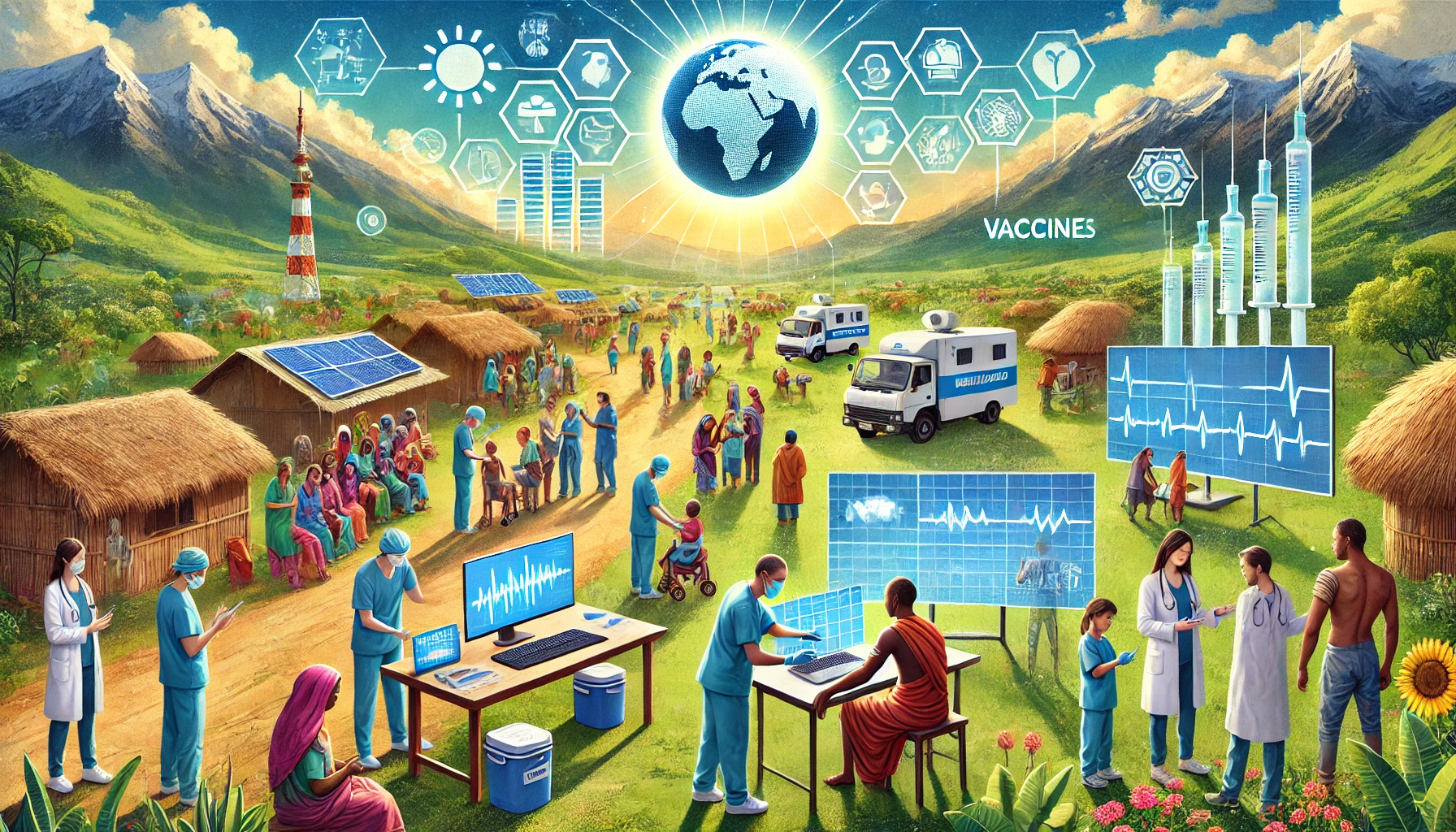Access to vaccines and preventive healthcare is a cornerstone of global health. Despite advances, millions lack access due to logistical, financial, and systemic barriers. Here’s a bold strategy to ensure life-saving healthcare reaches everyone, fostering healthier societies worldwide.
SUMMARY
The Problem: Over 1 billion people globally lack access to vaccines and preventive care, leading to preventable illnesses and economic strain.
The Solution: A multi-faceted initiative combining digital innovation, community engagement, and global partnerships to expand vaccine distribution, infrastructure, and education.
Impact: Improved global health, reduced healthcare costs, and stronger, more resilient communities.
Key Stakeholders: Governments, NGOs, private sector, and local communities.
Call to Action: Stakeholders must unite to fund, implement, and sustain scalable solutions.
CONTEXT
Access to vaccines and preventive healthcare is vital for combating infectious diseases, reducing health disparities, and improving economic outcomes. However, gaps persist due to poverty, conflict, and weak health systems. The COVID-19 pandemic underscored the importance of resilient health infrastructures and equitable vaccine distribution.
Failure to address this issue prolongs health crises, increases mortality, and exacerbates economic inequality.
CHALLENGES
- Logistical Barriers:
Transporting and storing vaccines require cold-chain logistics, often unavailable in rural areas. - Economic Inequity:
The cost of healthcare services and vaccines is prohibitive for low-income populations. - Misinformation and Hesitancy:
Cultural and social resistance, often fueled by misinformation, limits vaccine uptake. - Infrastructure Gaps:
Healthcare facilities are often inaccessible in remote or underserved areas. - Funding Shortages:
Underfunded health programmes hinder consistent access to vaccines and services.
Statistics: According to the WHO, over 20 million infants missed basic vaccinations in 2022, and preventable diseases like measles and polio are resurging in many regions.
GOALS
Short-Term (1-3 years):
- Ensure 90% vaccination coverage in targeted high-risk regions.
- Establish mobile clinics and telehealth platforms in underserved areas.
Long-Term (4-10 years):
- Develop self-sustaining vaccine distribution systems in low-income regions.
- Achieve universal access to preventive healthcare by 2035.
STAKEHOLDERS
- Governments: Policy creation, funding allocation, and infrastructure investment.
- NGOs and Charities: Programme implementation and community engagement.
- Private Sector: Technology and logistical innovations, funding contributions.
- Local Communities: Advocacy, participation in education and delivery initiatives.
SOLUTION
A comprehensive strategy involving innovation, infrastructure, and education:
1. Digital Vaccine Management Systems (DVMS)
- What It Involves: Develop a blockchain-based platform for vaccine tracking, distribution, and data transparency.
- Challenges It Addresses: Prevents vaccine wastage and ensures real-time monitoring of supply chains.
- Innovation: Leverages blockchain and AI to forecast vaccine demand and prevent bottlenecks.
- Scalability: Can be adopted globally with minimal localisation.
- Sustainability: Ensures equitable distribution and supports data-driven decision-making.
- Cost: Estimated £1.5 billion for global implementation over five years.
2. Mobile Clinics and Telehealth Expansion
- What It Involves: Deploy solar-powered mobile clinics equipped with vaccines and preventive care services in remote regions.
- Challenges It Addresses: Bridges gaps in healthcare access and provides education on preventive care.
- Innovation: Integrates portable diagnostic tools and telemedicine support for complex cases.
- Scalability: Can be deployed regionally and expanded globally.
- Sustainability: Reduces dependency on centralised facilities and empowers local healthcare workers.
- Cost: £2 billion for initial deployment in 50 countries.
3. Community-Led Health Campaigns
- What It Involves: Train community health workers (CHWs) to educate and vaccinate their communities.
- Challenges It Addresses: Combats misinformation and cultural hesitancy.
- Innovation: Utilises gamified mobile apps to educate CHWs and track progress.
- Scalability: Can be tailored to specific cultural and linguistic needs.
- Sustainability: Builds local capacity and trust in healthcare systems.
- Cost: £500 million for training and programme rollout in high-priority regions.
4. Global Vaccine Equity Fund (GVEF)
- What It Involves: Establish a fund to subsidise vaccine costs and support low-income countries.
- Challenges It Addresses: Ensures affordability and combats economic barriers.
- Innovation: Pool contributions from governments, tech giants, and philanthropy.
- Scalability: Provides a model for funding other global health initiatives.
- Sustainability: Guarantees continuous vaccine access for the underserved.
- Cost: £3 billion for 10 years.
IMPLEMENTATION
Timeline:
- Year 1: Launch DVMS pilot, procure mobile clinics, and set up the GVEF.
- Years 2-5: Scale mobile clinics and CHW campaigns. Expand DVMS globally.
- Years 6-10: Ensure universal coverage and phase out reliance on external funding.
Resources:
- Human: 100,000 CHWs, 10,000 mobile clinic staff.
- Financial: £7 billion over 10 years.
- Technological: Blockchain, AI, telehealth platforms, mobile diagnostic tools.
Risk Mitigation:
- Address vaccine hesitancy with localised campaigns.
- Build redundant supply chains to prevent disruptions.
- Continuously monitor and adapt programmes.
FINANCIALS
| Element | Cost (£) | Funding Sources |
|---|---|---|
| Digital Vaccine Systems | 1.5 billion | Governments, tech firms |
| Mobile Clinics | 2 billion | Philanthropy, global loans |
| Community-Led Campaigns | 500 million | NGOs, crowdfunding |
| Vaccine Equity Fund | 3 billion | G20 nations, corporations |
| Total | 7 billion |
Funding Sources:
- Governments: Public health budgets (£3 billion).
- Private Sector: Corporate social responsibility (£2 billion).
- Philanthropy: Foundations like the Gates Foundation (£1 billion).
- Crowdfunding: Global campaigns (£1 billion).
CASE STUDIES
- Gavi, the Vaccine Alliance: Demonstrated success in vaccine distribution through partnerships and funding mechanisms. Lessons include the importance of local buy-in and transparency.
- Africa CDC: Mobile clinics during COVID-19 proved effective in reaching remote areas.
IMPACT
Quantitative:
- 90% vaccination coverage in underserved regions.
- Reduced preventable deaths by 30% by 2030.
Qualitative:
- Strengthened trust in healthcare systems.
- Healthier populations contributing to economic growth.
Broader Benefits:
- Improved educational outcomes (healthier children).
- Reduced burden on healthcare systems.
CALL TO ACTION
The path to global health equity is clear, but urgent action is needed. Governments, corporations, and individuals must collaborate to fund and implement this initiative.
Next Steps:
- Commit funding and resources.
- Launch pilot programmes within one year.
- Scale successful models globally by 2030.

Leave a Reply